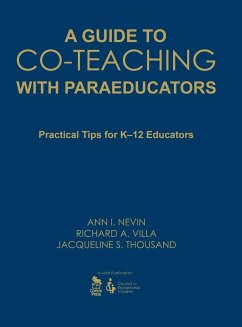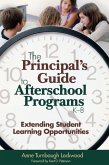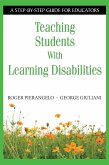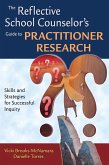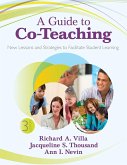Ann I. Nevin, Richard A. Villa, Jacqueline S. Thousand
A Guide to Co-Teaching with Paraeducators
Practical Tips for K-12 Educators
Ann I. Nevin, Richard A. Villa, Jacqueline S. Thousand
A Guide to Co-Teaching with Paraeducators
Practical Tips for K-12 Educators
- Gebundenes Buch
- Merkliste
- Auf die Merkliste
- Bewerten Bewerten
- Teilen
- Produkt teilen
- Produkterinnerung
- Produkterinnerung
To meet the demands of today's rigorous standards in inclusive classrooms, teachers are increasingly relying on paraeducators' assistance. This comprehensive guide highlights the benefits and challenges of collaborating with classroom assistants so that students with special needs have access to a highly qualified curriculum in the general education classroom and the individualized attention that promotes learning for all students. Masterfully woven throughout the book are accounts of three paraeducators whose experiences, challenges, and rewards illustrate the unique roles and…mehr
Andere Kunden interessierten sich auch für
![Teaching Students with Autism Spectrum Disorders Teaching Students with Autism Spectrum Disorders]() Roger PierangeloTeaching Students with Autism Spectrum Disorders77,99 €
Roger PierangeloTeaching Students with Autism Spectrum Disorders77,99 €![The Principal's Guide to Afterschool Programs, K-8 The Principal's Guide to Afterschool Programs, K-8]() Anne Turnbaugh LockwoodThe Principal's Guide to Afterschool Programs, K-854,99 €
Anne Turnbaugh LockwoodThe Principal's Guide to Afterschool Programs, K-854,99 €![Teaching Students With Learning Disabilities Teaching Students With Learning Disabilities]() Roger PierangeloTeaching Students With Learning Disabilities73,99 €
Roger PierangeloTeaching Students With Learning Disabilities73,99 €![The Reflective School Counselor's Guide to Practitioner Research The Reflective School Counselor's Guide to Practitioner Research]() Vicki Brooks-McNamaraThe Reflective School Counselor's Guide to Practitioner Research62,99 €
Vicki Brooks-McNamaraThe Reflective School Counselor's Guide to Practitioner Research62,99 €![Teaching Students With Autism Spectrum Disorders Teaching Students With Autism Spectrum Disorders]() Roger PierangeloTeaching Students With Autism Spectrum Disorders36,99 €
Roger PierangeloTeaching Students With Autism Spectrum Disorders36,99 €![Working With Families and Community Agencies to Support Students With Special Needs Working With Families and Community Agencies to Support Students With Special Needs]() Jim YsseldykeWorking With Families and Community Agencies to Support Students With Special Needs53,99 €
Jim YsseldykeWorking With Families and Community Agencies to Support Students With Special Needs53,99 €![A Guide to Co-Teaching A Guide to Co-Teaching]() Richard A. VillaA Guide to Co-Teaching38,99 €
Richard A. VillaA Guide to Co-Teaching38,99 €-
-
-
To meet the demands of today's rigorous standards in inclusive classrooms, teachers are increasingly relying on paraeducators' assistance. This comprehensive guide highlights the benefits and challenges of collaborating with classroom assistants so that students with special needs have access to a highly qualified curriculum in the general education classroom and the individualized attention that promotes learning for all students. Masterfully woven throughout the book are accounts of three paraeducators whose experiences, challenges, and rewards illustrate the unique roles and responsibilities that paraprofessionals carry out in K-12 classrooms. These vignettes demonstrate how educators and paraeducators can effectively collaborate in a climate of high-stakes testing, accountability, NCLB, and the reauthorization of IDEA 2004.
Produktdetails
- Produktdetails
- Verlag: Corwin
- Seitenzahl: 146
- Erscheinungstermin: 1. Oktober 2008
- Englisch
- Abmessung: 286mm x 221mm x 13mm
- Gewicht: 646g
- ISBN-13: 9781412957632
- ISBN-10: 141295763X
- Artikelnr.: 24954859
- Herstellerkennzeichnung
- Libri GmbH
- Europaallee 1
- 36244 Bad Hersfeld
- gpsr@libri.de
- Verlag: Corwin
- Seitenzahl: 146
- Erscheinungstermin: 1. Oktober 2008
- Englisch
- Abmessung: 286mm x 221mm x 13mm
- Gewicht: 646g
- ISBN-13: 9781412957632
- ISBN-10: 141295763X
- Artikelnr.: 24954859
- Herstellerkennzeichnung
- Libri GmbH
- Europaallee 1
- 36244 Bad Hersfeld
- gpsr@libri.de
Ann I. Nevin is professor emerita at Arizona State University and visiting professor at Florida International University. The author of books, research articles, and numerous chapters, Nevin is recognized for her scholarship and dedication to providing meaningful, practice-oriented, research-based strategies for teachers to integrate students with special learning needs. Since the 1970s, she has co-developed various innovative teacher education programs that affect an array of personnel, including the Vermont Consulting Teacher Program, Collaborative Consultation Project Re-Tool sponsored by the Council for Exceptional Children, the Arizona State University program for special educators to infuse self-determination skills throughout the curriculum, and the Urban SEALS (Special Education Academic Leaders) doctoral program at Florida International University. Her advocacy, research, and teaching spans more than 38 years of working with a diverse array of people to help students with disabilities succeed in normalized school environments. Nevin is known for action-oriented presentations, workshops, and classes that are designed to meet the individual needs of participants by encouraging introspection and personal discovery for optimal learning.
List of Tables and Figures
Acknowledgments
About the Authors
Introduction
1. Why Paraeducators? What Experience, History, Law, and Research Say!
Questions
What Are Paraeducators?
When Did Paraeducators First Become a Part of the American Classroom?
Meet Paraeducators: Ms. O. and Ms. Begay
What Does the Research Say About Paraeducators?
What Are the Current Legislative Mandates Regarding Paraeducators?
What Are the Potential Legal Challenges?
2. Meet the Teams
Questions
Meet Ms. Hernandez: The Elementary School Paraeducator and Her Team
Meet Ms. Bartolo: The Middle School Paraeducator and Her Team
Meet Mr. Anderson: The Secondary School Paraeducator and His Team
3. Refining Roles and Responsibilities of Paraeducators
Questions
What Are the Variety of Roles and Responsibilities That Paraeducators Take
On When They Work in Inclusive Classrooms?
What Are the Different Roles and Responsibilities for Others, Such as
Classroom Teachers, When They Work With Paraeducators in Inclusive
Classrooms?
What Is the Paraeducator's Role in the Instructional Cycle?
Gathering Information About Student Characteristics
Addressing Mismatches Between Student Characteristics and Classroom Demands
Ms. Hernandez: Elementary Paraeducator Roles and Responsibilities
Ms. Bartolo: Middle School Paraeducator Roles and Responsibilities
Mr. Anderson: Secondary School Paraeducator Roles and Responsibilities
Summary
4. Collaborative Processes: Tips and Strategies
Questions
Why Is the Collaborative Planning Process So Important?
What Are the Strategies to Make Planning Processes More Efficient?
What Are the Tips for Developing Interpersonal Relationships Among Team
Members?
How Are Effective Planning Teams Assessed?
Ms. Hernandez: Elementary Collaborative Planning Scenario
Ms. Bartolo: Middle Level Collaborative Planning Scenario
Mr. Anderson: Secondary School Collaborative Planning Scenario
5. Co-Teaching and Collaborative Approaches
Questions
Who Can Be Co-Teachers?
What Are the Four Approaches to Co-Teaching That Paraeducators Are Most
Likely to Experience When They Help Students in the General Education
Classroom?
Supportive Co-Teachers
Parallel Co-Teachers
Complementary Co-Teachers
Team Teachers
How Can Paraeducators Be Co-Teachers?
In What Ways Does a Co-Teaching Lesson Plan Format Help to Guide
Instruction?
Ms. Hernandez: Elementary Team Co-Teaching and Collaborative Approaches
Supportive, Parallel, and Complementary Co-Teaching in Second-Grade
Homeroom Language Arts Time
Supportive, Parallel, and Complementary Co-Teaching in Third-Grade Homeroom
Math Time
Ms. Bartolo: Middle School Co-Teaching and Collaborative Planning
Supportive, Parallel, and Complementary Co-Teaching in English Classes
Supportive and Complementary Co-Teaching in Science Class
Parallel Co-Teaching in the Learning Center
Mr. Anderson: Secondary Team Co-Teaching and Collaborative Planning
Adjusting Co-Teaching to Support Student Needs
Supportive and Parallel Co-Teaching in Social Studies
Summary
6. Systems Supports for Paraeducators' Success: Professional Development,
Supervision, and Logistical Supports
Questions
What Professional Development Do Paraeducators Need and What Are the Skills
Required for Paraeducators?
What Are the Approaches to Professional Development for Paraeducators?
What the Law Requires
What a Job Analysis Suggests
What Standards of Professional Organizations Suggest
What Should Paraeducators Expect From Teachers in Terms of Supervision and
Coaching?
On-the-Job Training
Formal Professional Development
What Are Dimensions of Effective Supervision for Paraeducators?
What Supervision Is and Is Not
Melding Supervision and Professional Development: A Cyclical Model
What Are Logistical Supports? What Logistical Supports Help Paraeducators
to Be Welcomed and Supported in Their Jobs?
Ms. Hernandez: Elementary Example of Professionl Development, Supervision,
and Logistical Support
Ms. Bartolo: Middle School Paraeducator Example of Professional
Development, Supervision, and Logistical Support
Mr. Anderson: Secondary School Paraeducator Example of Professional
Development, Supervision, and Logistical Support
Summary and Your Next Steps
7. Paraeducator: Collaborative Members of Inclusive Teams
Questions
Advice From Paraeducators in Co-Taught Classrooms
What Opinions and Advice Do Paraeducators Offer?
Ms. Sheila's Experience
Ms. Andrea's Experience
A National Study of Paraeducators in Inclusive Classrooms
Common Issues of Paraeducators in Inclusive Classrooms
Roles of Paraeducators in Inclusive Classrooms
Advice Paraeducators Offer
Advice From Paraeducator Scenarios
Ms. Hernandez: Elementary Scenario
Ms. Bartolo: Middle School Scenario
Mr. Anderson: Secondary School Scenario
Summary
Resources
A: Co-Teaching Roles and Responsibilities Matrix
B: Gathering Information About Learners and Classroom Demands Template
C: Checklist of Supplementary Supports, Aids, and Services
D: Likes & Dislikes Team Summary
E: Planning Meeting Agenda
F: Are We Really a Collaborative Team?
G: SODAS
H: Lesson Plan Template
I: Professional Development Opportunities and Informative Web Sites
Glossary
References
Index
Acknowledgments
About the Authors
Introduction
1. Why Paraeducators? What Experience, History, Law, and Research Say!
Questions
What Are Paraeducators?
When Did Paraeducators First Become a Part of the American Classroom?
Meet Paraeducators: Ms. O. and Ms. Begay
What Does the Research Say About Paraeducators?
What Are the Current Legislative Mandates Regarding Paraeducators?
What Are the Potential Legal Challenges?
2. Meet the Teams
Questions
Meet Ms. Hernandez: The Elementary School Paraeducator and Her Team
Meet Ms. Bartolo: The Middle School Paraeducator and Her Team
Meet Mr. Anderson: The Secondary School Paraeducator and His Team
3. Refining Roles and Responsibilities of Paraeducators
Questions
What Are the Variety of Roles and Responsibilities That Paraeducators Take
On When They Work in Inclusive Classrooms?
What Are the Different Roles and Responsibilities for Others, Such as
Classroom Teachers, When They Work With Paraeducators in Inclusive
Classrooms?
What Is the Paraeducator's Role in the Instructional Cycle?
Gathering Information About Student Characteristics
Addressing Mismatches Between Student Characteristics and Classroom Demands
Ms. Hernandez: Elementary Paraeducator Roles and Responsibilities
Ms. Bartolo: Middle School Paraeducator Roles and Responsibilities
Mr. Anderson: Secondary School Paraeducator Roles and Responsibilities
Summary
4. Collaborative Processes: Tips and Strategies
Questions
Why Is the Collaborative Planning Process So Important?
What Are the Strategies to Make Planning Processes More Efficient?
What Are the Tips for Developing Interpersonal Relationships Among Team
Members?
How Are Effective Planning Teams Assessed?
Ms. Hernandez: Elementary Collaborative Planning Scenario
Ms. Bartolo: Middle Level Collaborative Planning Scenario
Mr. Anderson: Secondary School Collaborative Planning Scenario
5. Co-Teaching and Collaborative Approaches
Questions
Who Can Be Co-Teachers?
What Are the Four Approaches to Co-Teaching That Paraeducators Are Most
Likely to Experience When They Help Students in the General Education
Classroom?
Supportive Co-Teachers
Parallel Co-Teachers
Complementary Co-Teachers
Team Teachers
How Can Paraeducators Be Co-Teachers?
In What Ways Does a Co-Teaching Lesson Plan Format Help to Guide
Instruction?
Ms. Hernandez: Elementary Team Co-Teaching and Collaborative Approaches
Supportive, Parallel, and Complementary Co-Teaching in Second-Grade
Homeroom Language Arts Time
Supportive, Parallel, and Complementary Co-Teaching in Third-Grade Homeroom
Math Time
Ms. Bartolo: Middle School Co-Teaching and Collaborative Planning
Supportive, Parallel, and Complementary Co-Teaching in English Classes
Supportive and Complementary Co-Teaching in Science Class
Parallel Co-Teaching in the Learning Center
Mr. Anderson: Secondary Team Co-Teaching and Collaborative Planning
Adjusting Co-Teaching to Support Student Needs
Supportive and Parallel Co-Teaching in Social Studies
Summary
6. Systems Supports for Paraeducators' Success: Professional Development,
Supervision, and Logistical Supports
Questions
What Professional Development Do Paraeducators Need and What Are the Skills
Required for Paraeducators?
What Are the Approaches to Professional Development for Paraeducators?
What the Law Requires
What a Job Analysis Suggests
What Standards of Professional Organizations Suggest
What Should Paraeducators Expect From Teachers in Terms of Supervision and
Coaching?
On-the-Job Training
Formal Professional Development
What Are Dimensions of Effective Supervision for Paraeducators?
What Supervision Is and Is Not
Melding Supervision and Professional Development: A Cyclical Model
What Are Logistical Supports? What Logistical Supports Help Paraeducators
to Be Welcomed and Supported in Their Jobs?
Ms. Hernandez: Elementary Example of Professionl Development, Supervision,
and Logistical Support
Ms. Bartolo: Middle School Paraeducator Example of Professional
Development, Supervision, and Logistical Support
Mr. Anderson: Secondary School Paraeducator Example of Professional
Development, Supervision, and Logistical Support
Summary and Your Next Steps
7. Paraeducator: Collaborative Members of Inclusive Teams
Questions
Advice From Paraeducators in Co-Taught Classrooms
What Opinions and Advice Do Paraeducators Offer?
Ms. Sheila's Experience
Ms. Andrea's Experience
A National Study of Paraeducators in Inclusive Classrooms
Common Issues of Paraeducators in Inclusive Classrooms
Roles of Paraeducators in Inclusive Classrooms
Advice Paraeducators Offer
Advice From Paraeducator Scenarios
Ms. Hernandez: Elementary Scenario
Ms. Bartolo: Middle School Scenario
Mr. Anderson: Secondary School Scenario
Summary
Resources
A: Co-Teaching Roles and Responsibilities Matrix
B: Gathering Information About Learners and Classroom Demands Template
C: Checklist of Supplementary Supports, Aids, and Services
D: Likes & Dislikes Team Summary
E: Planning Meeting Agenda
F: Are We Really a Collaborative Team?
G: SODAS
H: Lesson Plan Template
I: Professional Development Opportunities and Informative Web Sites
Glossary
References
Index
List of Tables and Figures
Acknowledgments
About the Authors
Introduction
1. Why Paraeducators? What Experience, History, Law, and Research Say!
Questions
What Are Paraeducators?
When Did Paraeducators First Become a Part of the American Classroom?
Meet Paraeducators: Ms. O. and Ms. Begay
What Does the Research Say About Paraeducators?
What Are the Current Legislative Mandates Regarding Paraeducators?
What Are the Potential Legal Challenges?
2. Meet the Teams
Questions
Meet Ms. Hernandez: The Elementary School Paraeducator and Her Team
Meet Ms. Bartolo: The Middle School Paraeducator and Her Team
Meet Mr. Anderson: The Secondary School Paraeducator and His Team
3. Refining Roles and Responsibilities of Paraeducators
Questions
What Are the Variety of Roles and Responsibilities That Paraeducators Take
On When They Work in Inclusive Classrooms?
What Are the Different Roles and Responsibilities for Others, Such as
Classroom Teachers, When They Work With Paraeducators in Inclusive
Classrooms?
What Is the Paraeducator's Role in the Instructional Cycle?
Gathering Information About Student Characteristics
Addressing Mismatches Between Student Characteristics and Classroom Demands
Ms. Hernandez: Elementary Paraeducator Roles and Responsibilities
Ms. Bartolo: Middle School Paraeducator Roles and Responsibilities
Mr. Anderson: Secondary School Paraeducator Roles and Responsibilities
Summary
4. Collaborative Processes: Tips and Strategies
Questions
Why Is the Collaborative Planning Process So Important?
What Are the Strategies to Make Planning Processes More Efficient?
What Are the Tips for Developing Interpersonal Relationships Among Team
Members?
How Are Effective Planning Teams Assessed?
Ms. Hernandez: Elementary Collaborative Planning Scenario
Ms. Bartolo: Middle Level Collaborative Planning Scenario
Mr. Anderson: Secondary School Collaborative Planning Scenario
5. Co-Teaching and Collaborative Approaches
Questions
Who Can Be Co-Teachers?
What Are the Four Approaches to Co-Teaching That Paraeducators Are Most
Likely to Experience When They Help Students in the General Education
Classroom?
Supportive Co-Teachers
Parallel Co-Teachers
Complementary Co-Teachers
Team Teachers
How Can Paraeducators Be Co-Teachers?
In What Ways Does a Co-Teaching Lesson Plan Format Help to Guide
Instruction?
Ms. Hernandez: Elementary Team Co-Teaching and Collaborative Approaches
Supportive, Parallel, and Complementary Co-Teaching in Second-Grade
Homeroom Language Arts Time
Supportive, Parallel, and Complementary Co-Teaching in Third-Grade Homeroom
Math Time
Ms. Bartolo: Middle School Co-Teaching and Collaborative Planning
Supportive, Parallel, and Complementary Co-Teaching in English Classes
Supportive and Complementary Co-Teaching in Science Class
Parallel Co-Teaching in the Learning Center
Mr. Anderson: Secondary Team Co-Teaching and Collaborative Planning
Adjusting Co-Teaching to Support Student Needs
Supportive and Parallel Co-Teaching in Social Studies
Summary
6. Systems Supports for Paraeducators' Success: Professional Development,
Supervision, and Logistical Supports
Questions
What Professional Development Do Paraeducators Need and What Are the Skills
Required for Paraeducators?
What Are the Approaches to Professional Development for Paraeducators?
What the Law Requires
What a Job Analysis Suggests
What Standards of Professional Organizations Suggest
What Should Paraeducators Expect From Teachers in Terms of Supervision and
Coaching?
On-the-Job Training
Formal Professional Development
What Are Dimensions of Effective Supervision for Paraeducators?
What Supervision Is and Is Not
Melding Supervision and Professional Development: A Cyclical Model
What Are Logistical Supports? What Logistical Supports Help Paraeducators
to Be Welcomed and Supported in Their Jobs?
Ms. Hernandez: Elementary Example of Professionl Development, Supervision,
and Logistical Support
Ms. Bartolo: Middle School Paraeducator Example of Professional
Development, Supervision, and Logistical Support
Mr. Anderson: Secondary School Paraeducator Example of Professional
Development, Supervision, and Logistical Support
Summary and Your Next Steps
7. Paraeducator: Collaborative Members of Inclusive Teams
Questions
Advice From Paraeducators in Co-Taught Classrooms
What Opinions and Advice Do Paraeducators Offer?
Ms. Sheila's Experience
Ms. Andrea's Experience
A National Study of Paraeducators in Inclusive Classrooms
Common Issues of Paraeducators in Inclusive Classrooms
Roles of Paraeducators in Inclusive Classrooms
Advice Paraeducators Offer
Advice From Paraeducator Scenarios
Ms. Hernandez: Elementary Scenario
Ms. Bartolo: Middle School Scenario
Mr. Anderson: Secondary School Scenario
Summary
Resources
A: Co-Teaching Roles and Responsibilities Matrix
B: Gathering Information About Learners and Classroom Demands Template
C: Checklist of Supplementary Supports, Aids, and Services
D: Likes & Dislikes Team Summary
E: Planning Meeting Agenda
F: Are We Really a Collaborative Team?
G: SODAS
H: Lesson Plan Template
I: Professional Development Opportunities and Informative Web Sites
Glossary
References
Index
Acknowledgments
About the Authors
Introduction
1. Why Paraeducators? What Experience, History, Law, and Research Say!
Questions
What Are Paraeducators?
When Did Paraeducators First Become a Part of the American Classroom?
Meet Paraeducators: Ms. O. and Ms. Begay
What Does the Research Say About Paraeducators?
What Are the Current Legislative Mandates Regarding Paraeducators?
What Are the Potential Legal Challenges?
2. Meet the Teams
Questions
Meet Ms. Hernandez: The Elementary School Paraeducator and Her Team
Meet Ms. Bartolo: The Middle School Paraeducator and Her Team
Meet Mr. Anderson: The Secondary School Paraeducator and His Team
3. Refining Roles and Responsibilities of Paraeducators
Questions
What Are the Variety of Roles and Responsibilities That Paraeducators Take
On When They Work in Inclusive Classrooms?
What Are the Different Roles and Responsibilities for Others, Such as
Classroom Teachers, When They Work With Paraeducators in Inclusive
Classrooms?
What Is the Paraeducator's Role in the Instructional Cycle?
Gathering Information About Student Characteristics
Addressing Mismatches Between Student Characteristics and Classroom Demands
Ms. Hernandez: Elementary Paraeducator Roles and Responsibilities
Ms. Bartolo: Middle School Paraeducator Roles and Responsibilities
Mr. Anderson: Secondary School Paraeducator Roles and Responsibilities
Summary
4. Collaborative Processes: Tips and Strategies
Questions
Why Is the Collaborative Planning Process So Important?
What Are the Strategies to Make Planning Processes More Efficient?
What Are the Tips for Developing Interpersonal Relationships Among Team
Members?
How Are Effective Planning Teams Assessed?
Ms. Hernandez: Elementary Collaborative Planning Scenario
Ms. Bartolo: Middle Level Collaborative Planning Scenario
Mr. Anderson: Secondary School Collaborative Planning Scenario
5. Co-Teaching and Collaborative Approaches
Questions
Who Can Be Co-Teachers?
What Are the Four Approaches to Co-Teaching That Paraeducators Are Most
Likely to Experience When They Help Students in the General Education
Classroom?
Supportive Co-Teachers
Parallel Co-Teachers
Complementary Co-Teachers
Team Teachers
How Can Paraeducators Be Co-Teachers?
In What Ways Does a Co-Teaching Lesson Plan Format Help to Guide
Instruction?
Ms. Hernandez: Elementary Team Co-Teaching and Collaborative Approaches
Supportive, Parallel, and Complementary Co-Teaching in Second-Grade
Homeroom Language Arts Time
Supportive, Parallel, and Complementary Co-Teaching in Third-Grade Homeroom
Math Time
Ms. Bartolo: Middle School Co-Teaching and Collaborative Planning
Supportive, Parallel, and Complementary Co-Teaching in English Classes
Supportive and Complementary Co-Teaching in Science Class
Parallel Co-Teaching in the Learning Center
Mr. Anderson: Secondary Team Co-Teaching and Collaborative Planning
Adjusting Co-Teaching to Support Student Needs
Supportive and Parallel Co-Teaching in Social Studies
Summary
6. Systems Supports for Paraeducators' Success: Professional Development,
Supervision, and Logistical Supports
Questions
What Professional Development Do Paraeducators Need and What Are the Skills
Required for Paraeducators?
What Are the Approaches to Professional Development for Paraeducators?
What the Law Requires
What a Job Analysis Suggests
What Standards of Professional Organizations Suggest
What Should Paraeducators Expect From Teachers in Terms of Supervision and
Coaching?
On-the-Job Training
Formal Professional Development
What Are Dimensions of Effective Supervision for Paraeducators?
What Supervision Is and Is Not
Melding Supervision and Professional Development: A Cyclical Model
What Are Logistical Supports? What Logistical Supports Help Paraeducators
to Be Welcomed and Supported in Their Jobs?
Ms. Hernandez: Elementary Example of Professionl Development, Supervision,
and Logistical Support
Ms. Bartolo: Middle School Paraeducator Example of Professional
Development, Supervision, and Logistical Support
Mr. Anderson: Secondary School Paraeducator Example of Professional
Development, Supervision, and Logistical Support
Summary and Your Next Steps
7. Paraeducator: Collaborative Members of Inclusive Teams
Questions
Advice From Paraeducators in Co-Taught Classrooms
What Opinions and Advice Do Paraeducators Offer?
Ms. Sheila's Experience
Ms. Andrea's Experience
A National Study of Paraeducators in Inclusive Classrooms
Common Issues of Paraeducators in Inclusive Classrooms
Roles of Paraeducators in Inclusive Classrooms
Advice Paraeducators Offer
Advice From Paraeducator Scenarios
Ms. Hernandez: Elementary Scenario
Ms. Bartolo: Middle School Scenario
Mr. Anderson: Secondary School Scenario
Summary
Resources
A: Co-Teaching Roles and Responsibilities Matrix
B: Gathering Information About Learners and Classroom Demands Template
C: Checklist of Supplementary Supports, Aids, and Services
D: Likes & Dislikes Team Summary
E: Planning Meeting Agenda
F: Are We Really a Collaborative Team?
G: SODAS
H: Lesson Plan Template
I: Professional Development Opportunities and Informative Web Sites
Glossary
References
Index

